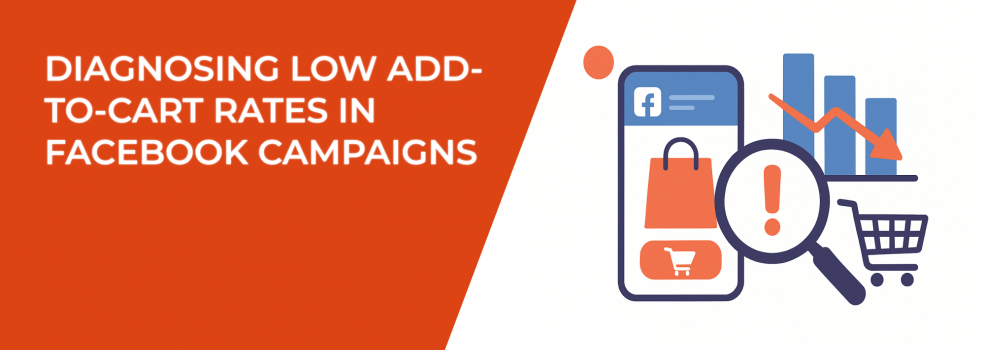You launch a Facebook campaign. The ad starts getting clicks, the reach is strong, and your CPC looks decent. But when you check the numbers, the “Add to Cart” rate is painfully low.
The traffic is arriving, but the carts remain empty. Why?
Low add-to-cart rates are one of the clearest signals that something is off in your sales funnel. It’s not always just about the ad itself — it can be targeting, creative, landing page experience, or even product positioning. The challenge is knowing where to look first, and how to fix it without wasting budget.
Let’s walk through a structured approach that advertisers and marketers can use to diagnose the problem.
1. Start With Audience Targeting
Even the most compelling creative will fail if it’s reaching the wrong people.
When diagnosing low add-to-cart rates, the first thing to check is whether your ads are being shown to users with genuine buying intent. Facebook’s targeting tools can reach millions of people, but broad reach often means lower quality traffic.
Questions to ask yourself:
-
Am I using lookalike audiences based on past purchasers or just page visitors?
-
Are my interest and behavior layers tuned to match people who are ready to buy, not just curious?
-
Do my demographics match my ideal buyer profile, or am I seeing wasted impressions in low-performing segments?
Example: if you’re selling high-end fitness gear and your targeting is set to “Fitness and Wellness” in general, your ads may reach people who only watch workout videos — not those actively shopping for premium gear. A small tweak toward behavior-based targeting, such as “recent online shoppers” or “purchased fitness equipment in the last 90 days,” can lift intent and improve your add-to-cart rate.
If you suspect targeting might be the culprit, it’s worth revisiting the fundamentals — our Facebook Ad Targeting 101 guide walks you through proven methods to ensure your ads reach the people most likely to buy.
2. Match Creative With Intent
Your ad creative sets expectations. If the experience after the click doesn’t match, you lose momentum fast.
Think about the last time you clicked an ad that looked exciting, only to land on a bland product page. Disappointing, right? That same disconnect happens when your creative doesn’t align with your landing page’s offer and tone.
What to check:
-
Visual consistency — Are your ad images or videos showcasing the exact product and style that appears on the landing page?
-
Message clarity — Is the benefit in the ad carried through on the product page, or does it shift focus?
-
CTA alignment — Does the ad invite the user to “Shop Now” but drop them on a blog post instead of a product page?
Pro tip: The more seamless the transition from ad to page, the more likely users are to continue to “Add to Cart.” That means echoing the same colors, images, and key benefits from your ad in your landing experience.
3. Remove Landing Page Friction
A slow or confusing landing page is a conversion killer. People don’t have the patience to hunt for your “Add to Cart” button or wait five seconds for a page to load.
Audit your landing page for friction points:
-
Load speed — Anything over three seconds on mobile is a warning sign.
-
Button visibility — Can users add to cart without scrolling?
-
Distraction overload — Are there pop-ups, banners, or unnecessary steps in the purchase path?
Example: An online apparel brand saw a 25% lift in add-to-cart rate simply by moving the “Add to Cart” button above the fold on mobile, reducing load time, and trimming product copy to the essentials.
4. Reassess Product-Market Fit
Sometimes the problem isn’t the ad or the landing page — it’s the offer itself.
If your price is far above perceived value or your product isn’t solving an immediate need, even the best ads won’t push shoppers to act. This can be a tough realization, but it’s better to face it early.
Signals that product-market fit may be the issue:
-
Consistently low add-to-cart rates across all audience segments.
-
High page engagement (people scroll, read, and click images) but no add-to-cart action.
-
Feedback from comments or messages suggesting hesitation about price or features.
Test smaller bundles, limited-time discounts, or product variations to see if engagement turns into action.
5. Dig Into Post-Click Data
Facebook tells you what happens before the click. Your analytics platform tells you what happens after.
Set up event tracking for Add to Cart in Google Analytics or another analytics tool, and compare behaviors between converting and non-converting sessions.
Metrics worth monitoring:
-
Bounce rate on product pages.
-
Session duration and pages per session for non-buyers vs. buyers.
-
Exit page reports to see where people drop off.
If most users leave within seconds, the issue is likely speed or relevancy. If they linger but don’t convert, your offer or trust signals may need work.
Once you’ve fixed targeting and creative issues, you can still recover lost sales by retargeting cart abandoners — here’s how to set up high-converting abandoned cart campaigns.
Bringing It All Together
Diagnosing low add-to-cart rates in Facebook campaigns isn’t about chasing a single “magic fix.” It’s about methodically checking each step of the funnel — targeting, creative, landing page, product-market fit, and analytics — until you identify where interest is fading.
Once you pinpoint the bottleneck, improvements compound quickly. A tighter audience brings in better traffic, a matching creative flow keeps them engaged, and a smooth landing page clears the path to purchase.
When all these pieces work together, your add-to-cart rate can shift from frustratingly low to consistently healthy — and that’s when Facebook campaigns become a growth engine instead of a budget drain.

